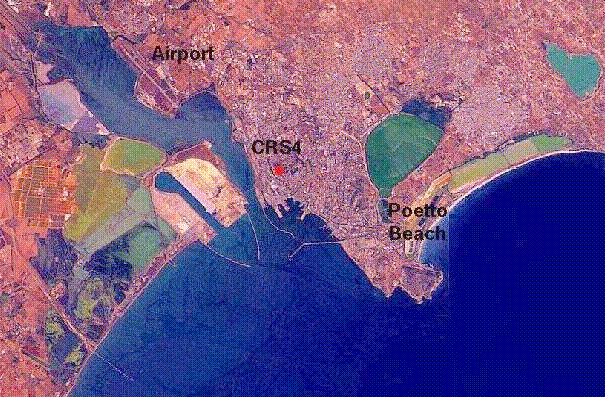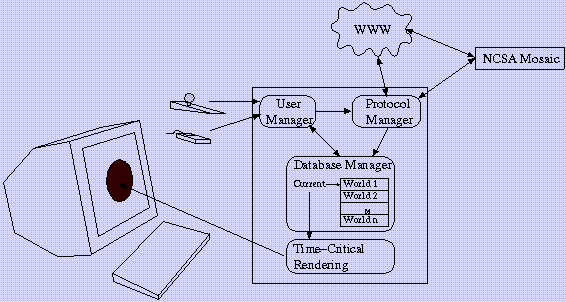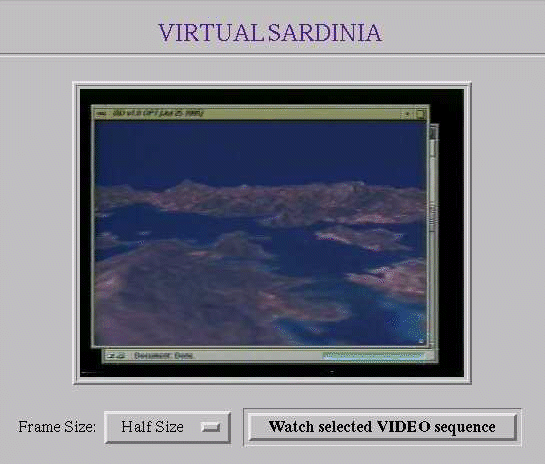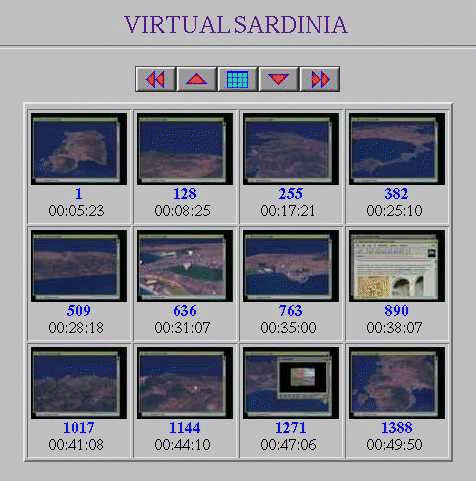Virtual Sardinia: A Large-Scale Hypermedia Regional Information System
Enrico Gobbetti (1)(2)
and
Andrea O. Leone (3)
(1) UMBC, CSEE Dept., Baltimore, MD, USA
(2) CESDIS , NASA GSFC, Greenbelt, MD, USA
(3) CRS4 , Via Sauro 10, 09123 Cagliari, Italy
E-mail:
gobbetti@cs.umbc.edu,
cirio@crs4.it
Goals and Motivation
Approach
Data gathering and database creation
World-Wide Web to combine heterogeneous distributed databases
Development of specialized visualization/navigation tools integrated
in a Web framework
Accessing Information
Cross-referencing through hyperlinks
Multiple indexes and search engines
Emphasis on georeferenced data
Terrain visualization
Hyperlinks on the terrain
Why Georeferenced Data?
Easily readable maps with markers
The terrain model becomes an index
Useful with cross references to and from other data sources
Natural complement to other search techniques

Why 3D Navigation?
The terrain shape is a source of information in itself!
Habitat and landscape boundaries have simpler connotations
Interactive exploration of a 3D model allows
users to discover features not easily detectable using traditional 2D
cartographic representations
2D operation (pan/zoom) can be obtained naturally in 3D by constraining
the camera motion

Virtual Sardinia Overall View

Making 3D Navigation Possible and Practical
Create a 3D model from satellite images and elevation data
Annotate the 3D model with markers referring to other documents
Use an interactive 3D viewer to explore the model
Original Terrain Model
Color: Landsat scene, 5279 x 10881 pixels, bands 3 2 1 (RGB) [30 m resolution resampled to 25 m]
Elevation: 359x681 regular grid [400 m resolution]
Much too big for interactive exploration
Brute-force rendering would require 500K triangles/frame
Impossible to meet latency and visual feedback constraints even with
high-end machines
At least ten frames per second required to give the illusion
of smooth motion
Need for data reduction and multiresolution viewing
Multiresolution Terrain Model
Texture-mapping of image onto elevation grid
Subdivision of the model into 16x10 quadrants that can be
handled independently
Image simplification
Resizing to fit into machine texture memory
Geometry simplification
Regular grid converted to irregular triangle net
Three levels of detail (LOD) per quadrant created by triangle decimation Entire Model complexity: 41987-108617 triangles
Automatic trading of quality/speed at rendering time
speed
Hyperlinks from each quadrant to a high resolution version of the surrounding region
User-controlled quality increase
i3D: High-Speed VRML Browser
VRML-1.0 compatible
Continuous 6 DOF camera motion control using a Spaceball
Stereo on workstation monitor/projection screen using Stereographics CrystalEyes
Time-critical rendering to support navigation in very large scenes

i3D: Time-Critical Rendering
Adaptive trading of rendering quality with speed
Hierarchical culling based on octree spatial subdivision
Per object level of detail selection based on relative object importance, computed using projected size on screen
Feedback algorithm adjusts LOD selection algorithm parameters to meet timing constraints
Per object update rates used to exploit frame coherency and reduce per-frame computation
Very large databases can be rendered at interactive speeds
Performance comparable to high-end VR systems
Alternative 3D Navigation Tools
Weblive - distribution of prerecorded sequences
Webshow - frame indexing for sequence selection


Demonstration Video
Recorded live on a Silicon Graphics Onyx RE2.
Interactive sessions were not edited (except for elimination of network latencies).
Conclusions
Interactive 3D viewer used as a front end to query information about
georeferenced data
A useful complement, not a replacement of other search techniques
Possible to interactively explore large terrain models
Bottleneck is data transfert, not graphics performance
Principal Future Works
Better integration among different components
Thematic navigation and guided tours
3D animation and simulation (evolution of terrain in time)
Specialized terrain visualization tools
GIS features and route planning
Data reduction for network transfert
Extended availability to the internet community
Availability
Virtual Sardinia available on the internet at the address http://www.crs4.it/PRJ/VIRTSARD/
Work in progress: stay tuned!
i3D available on the internet at the address http://sgvenus.cern.ch/i3d/
Work continued at CERN by the VENUS group
Acknowledgments
Research and development carried out at the Center for Research,
Development, and Advanced Studies in Sardinia (CRS4), Cagliari, Italy
Satellite and elevation data provided by the Earth Sciences Department of the
University of Cagliari, Italy
Financial support of the Sardinian Regional Authorities






